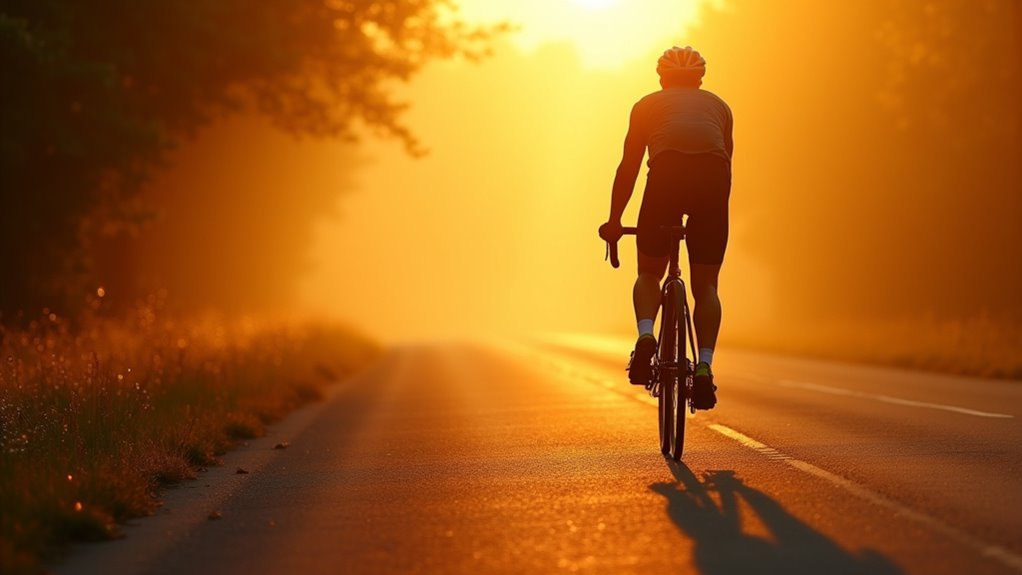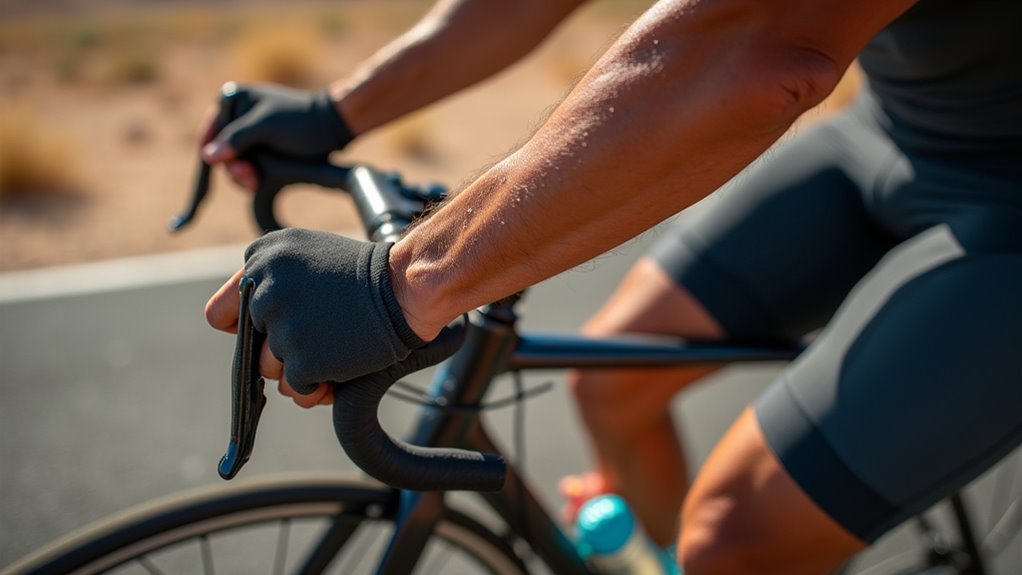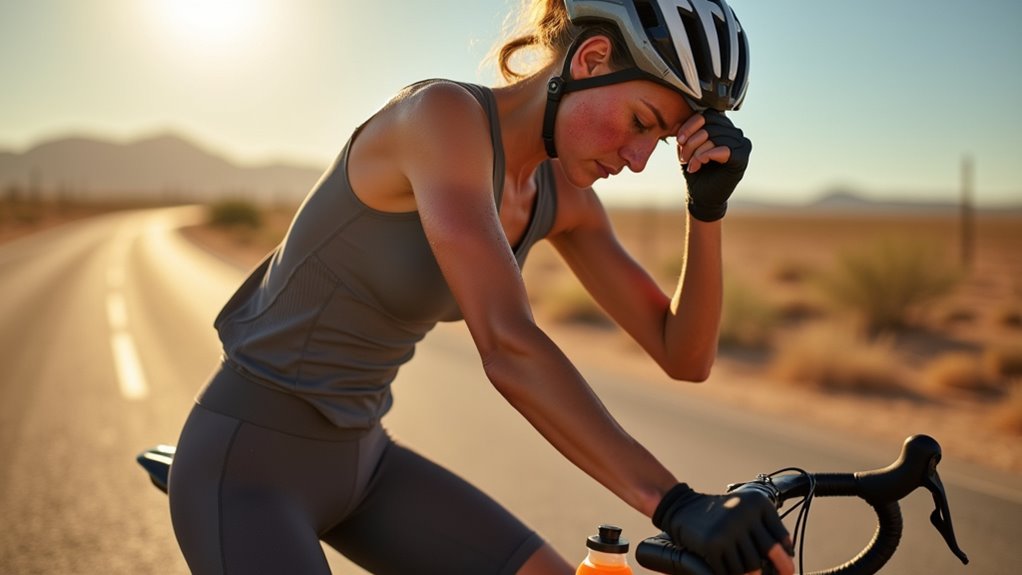Physical Address
304 North Cardinal St.
Dorchester Center, MA 02124
Physical Address
304 North Cardinal St.
Dorchester Center, MA 02124

Beat the heat with essential summer cycling strategies that could mean the difference between your best ride and your last.
You might be surprised to learn that heat-related cycling incidents spike by 40% when temperatures exceed 85°F, yet most cyclists continue their regular routines without adjusting their approach. Summer doesn’t have to derail your biking goals, but it’ll demand smarter strategies than simply powering through the heat. The difference between a invigorating ride and a dangerous struggle often comes down to five key adjustments that experienced cyclists swear by—timing decisions that could transform your hottest rides into your most enjoyable ones.

When the summer sun reaches its peak between 10 AM and 4 PM, you’re fundamentally volunteering to ride through nature’s oven. Smart cyclists embrace the golden hours—dawn and dusk—when temperatures drop and traffic thins. Early morning rides offer crisp air and peaceful roads, while evening sessions provide stunning sunsets and cooler breezes.
In Mediterranean cultures, the siesta isn’t laziness—it’s survival wisdom. They’ve mastered avoiding midday heat for centuries. You should adopt this approach. Plan your routes around shaded paths during unavoidable midday rides. Parks with tree canopies and bike trails along rivers naturally stay cooler.
Check weather apps for hourly temperature forecasts. That 15-degree difference between 7 AM and noon could transform your ride from enjoyable to miserable. Time isn’t just money—it’s comfort.
For those seeking the ultimate cool-weather cycling experience, consider exploring glacier climbing trails in the US, where temperatures remain refreshingly low even during summer months.
Your clothing becomes your first line of defense against summer’s assault, yet many cyclists still reach for cotton t-shirts and dark colors—a recipe for overheating disaster. Instead, you’ll want moisture-wicking synthetic fabrics or merino wool in light colors that reflect heat rather than absorb it.
Your helmet needs proper ventilation—those extra vents aren’t just for show. Pair it with cycling sunglasses that wrap around your face, protecting against UV rays and wind-dried eyes. Don’t forget lightweight, breathable gloves; sweaty palms lose grip fast.
Consider arm sleeves and leg warmers you can remove as temperatures climb. A cycling cap under your helmet prevents sweat from stinging your eyes, while UV-protective clothing shields exposed skin without the constant sunscreen reapplication.
For early morning or late evening rides when visibility drops, invest in a reliable camping lantern that can provide hands-free illumination for bike maintenance or campsite setup during multi-day cycling adventures.

Even the best moisture-wicking gear won’t save you if you’re already behind on fluids. Start hydrating two hours before your ride—not when you’re already thirsty. That’s your body’s late-stage warning system.
Ditch the “eight glasses a day” myth. You’ll need 16-24 ounces per hour of moderate cycling, more in extreme heat. Plain water works for rides under 90 minutes, but longer sessions demand electrolytes.
Sports drinks aren’t your only option—coconut water or diluted fruit juice with a pinch of salt does the trick.
Here’s what pros know: cool fluids absorb faster than room temperature ones. Keep bottles in insulated cages or freeze half-full bottles overnight, then top off before riding. Your core temperature will thank you.
If you’re planning multi-day cycling adventures, these same hydration principles apply whether you’re camping under the stars or staying in hotels along your route.
Smart cyclists know that summer route planning isn’t just about distance—it’s about survival. You’ll want to map out tree-lined streets, park paths, and neighborhoods with mature canopies before heading out. Early morning rides offer natural shade from buildings casting long shadows eastward, while late afternoon routes should prioritize westward shade coverage.
Use mapping apps that show elevation changes—steep climbs in blazing heat aren’t just uncomfortable, they’re dangerous. Seek out bike paths near rivers or lakes where temperatures drop several degrees.
Plan rest stops at libraries, coffee shops, or community centers for emergency cooling breaks.
Always have backup routes mapped to shaded areas if you start overheating. Your phone’s weather app becomes your best friend—check real-time temperatures and UV indexes before departing. Consider waterside routes along marinas or harbors where you can enjoy cooling breezes and potentially spot used boats for sale if you’re interested in expanding your recreational activities beyond cycling.

No matter how perfectly you’ve planned your shaded route, heat exhaustion can still sneak up on you when you’re pushing pedals under the summer sun. Watch for early warning signs: excessive sweating followed by suddenly stopping sweating, dizziness, nausea, or feeling unusually fatigued.
Your body’s telling you something’s wrong when you experience headaches, muscle cramps, or confusion while riding.
If you notice these symptoms, stop immediately. Find shade, remove your helmet, and sip water slowly—don’t chug it. Many cyclists push through discomfort thinking it’s normal summer riding, but heat exhaustion progresses quickly to dangerous heat stroke.
Trust your instincts. If something feels off, it probably is. There’s no shame in cutting your ride short—your health trumps any training schedule.
Just like family camping requires careful preparation for safety and enjoyment, summer cycling demands the same attention to heat-related risks.
You’ve got everything you need to conquer summer cycling like a desert nomad exploring scorching sands with wisdom and preparation. Remember, it’s not about being the toughest rider out there—it’s about being the smartest. Trust your body’s signals, stick to your hydration plan, and don’t let pride override common sense. When you respect the heat and plan accordingly, you’ll discover that summer cycling can become one of your most rewarding seasonal adventures.